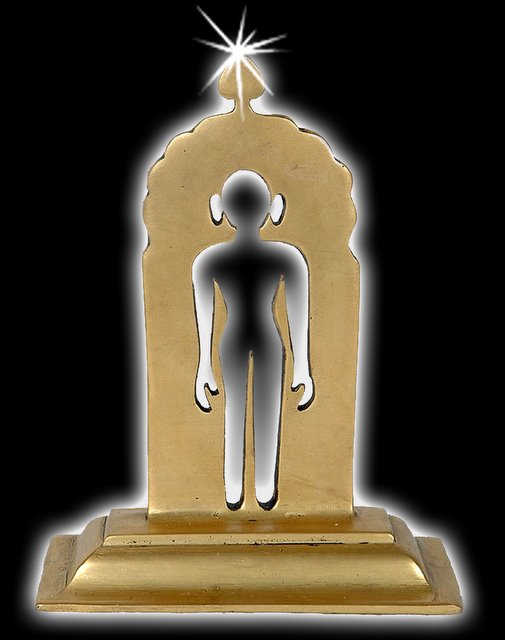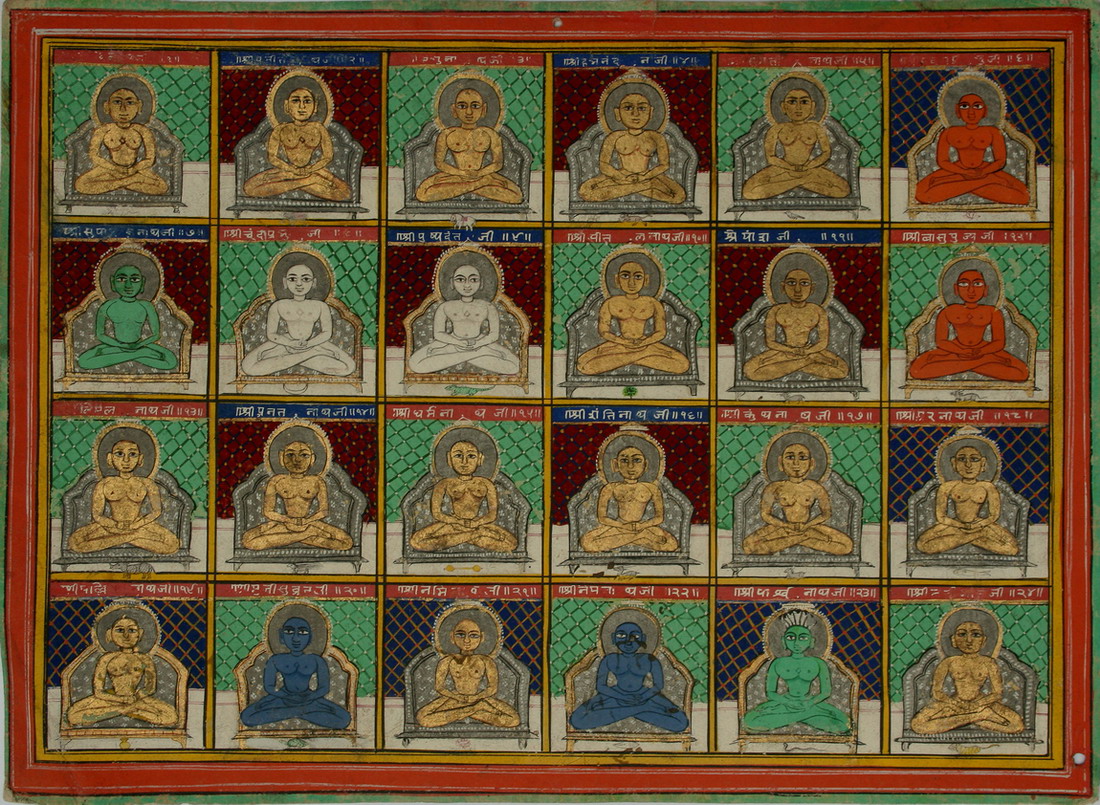|
ŠĻÜamŇćkńĀra Mantra
The ŠĻÜamŇćkńĀra mantra is the most significant mantra in Jainism, and one of the oldest mantras in continuous practice. This is the first prayer recited by the Jains while meditating. The mantra is also variously referred to as the ''Pancha NamaskńĀra Mantra'', ''NamaskńĀra Mantra'', ''NavakńĀra Mantra'', ''NamaskńĀra Mangala'' or ''Paramesthi Mantra''. It is dedicated to the Panch-Parmeshthi, namely the arihant, the siddhas, the acharyas, the upadhyaya and all the ascetics. History A short inscription (dated 200 BCE to 100 BCE) found in Pale Caves in Maharashtra mentions () or (), only the first line of Namokara Mantra. In Kushana and Shaka periods of 1st century CE to the first quarter of 2nd century, only the first line was prevalent. The Hathigumpha inscription dated between 2nd century BCE to 1st century CE starts with () and (), the first two lines of Namokar Mantra. The rest of the lines are not there. It was inscribed by the Jain monarch Kharavela of Kalin ... [...More Info...] [...Related Items...] OR: [Wikipedia] [Google] [Baidu] |
Jainism
Jainism ( ), also known as Jain Dharma, is an Indian religions, Indian religion whose three main pillars are nonviolence (), asceticism (), and a rejection of all simplistic and one-sided views of truth and reality (). Jainism traces its spiritual ideas and history through the succession of twenty-four , supreme preachers of ''dharma''. The first in the current time cycle is Rishabhadeva, who tradition holds lived millions of years ago; the 23rd is Parshvanatha, traditionally dated to the 9th century Common Era, BCE; and the 24th is MahńĀvńęra, Mahavira, who lived . Jainism is considered an eternal ''dharma'' with the guiding every time cycle of the Jain cosmology, cosmology. Central to understanding Jain philosophy is the concept of ''bhedavij√ĪńĀna'', or the clear distinction in the nature of the soul and non-soul entities. This principle underscores the innate purity and potential for liberation within every Jńęva (Jainism), soul, distinct from the physical and menta ... [...More Info...] [...Related Items...] OR: [Wikipedia] [Google] [Baidu] |
Pa√Īca-ParameŠĻ£ŠĻ≠hi
The () in Jainism is a fivefold hierarchy of religious authorities worthy of veneration. Overview The five supreme beings are: #'' Arihant'': The awakened souls who have attained kevala jnana are considered as Arihants. The 24 tirthankaras or Jinas, the legendary founding figures of Jainism in the present time cycle, are Arihants. All tirthankaras are Arihants, but not all Arihants are tirthankaras. #''Siddha'' (Ashiri): The souls which have been liberated from the birth and death cycle. #'' Acarya'' #''Upadhyaya'' ("Preceptors") #''Muni'' or '' Jain monks'' The five initials, viz. ''A+A+A+U+M'' are taken as forming the Aum syllable. Five supreme beings The more ancient canonical texts of the ŇövetńĀmbara sect mention ''Pa√Īca-ParameŠĻ£ŠĻ≠hi'' (five supreme beings) to be the venerable beings in the universe. The DravyasaŠĻÉgraha, a Digambara text, succinctly characterizes the five Supreme Beings (''Pa√Īca-ParameŠĻ£ŠĻ≠hi''). #Definition of the World Teacher (Arhat) ... [...More Info...] [...Related Items...] OR: [Wikipedia] [Google] [Baidu] |
Karma In Jainism
Karma is the basic principle within an overarching psycho-cosmology in Jainism. Human moral actions form the basis of the transmigration of the soul ('). The soul is constrained to a cycle of rebirth, trapped within the Temporality, temporal world ('), until it finally achieves liberation ('). Liberation is achieved by following a path of purification. Jains believe that karma is a physical substance that is everywhere in the universe. Karma particles are attracted to the soul by the actions of that soul. Karma particles are attracted when we do, think, or say things, when we kill something, when we lie, when we steal and so on. Karma not only encompasses the causality of transmigration, but is also conceived of as an extremely subtle matter, which infiltrates the soul‚ÄĒobscuring its natural, transparent and pure qualities. Karma is thought of as a kind of pollution, that taints the soul with various colours (''Lesya, leŇõyńĀ''). Based on its karma, a soul undergoes transmigr ... [...More Info...] [...Related Items...] OR: [Wikipedia] [Google] [Baidu] |
Upadhyay
Upadhyay is a surname. Notable people who bear the name include: *Amar Upadhyay (born 1976), Indian model, film and television actor *Amod Prasad Upadhyay (born 1936), Nepalese social worker and politician * Ayodhya Prasad Upadhyay (1865‚Äď1947), writer of Hindi literature * Brahmabandhav Upadhyay (1861‚Äď1907), Bengali Brahmin, nephew of the Indian freedom-fighter Kalicharan Banerjee * Chabilal Upadhyaya (1882‚Äď1980), Nepali Brahmin(Bahun), First President (Selected) of Assam Pradesh Congress Committee * Chintan Upadhyay (born 1972), Indian artist, accused of a 2015 murder * Chandrika Prasad Upadhyay (born 1950), Indian politician * Deendayal Upadhyaya (1916‚Äď1968), Indian politician and thinker, co-founder of the political party Bharatiya Jana Sangh * Darshan Upadhyaya (born 1994), Canada-born American esports player * Harilal Upadhyay (1916‚Äď1994), Gujarati author * Hema Upadhyay (1972‚Äď2015), Indian artist who lived and worked in Mumbai, India since 1998 * Kedar Nath ... [...More Info...] [...Related Items...] OR: [Wikipedia] [Google] [Baidu] |
Acharya
In Indian religions and society, an ''acharya'' (Sanskrit: ŗ§Üŗ§öŗ§ĺŗ§įŗ•ćŗ§Į, IAST: ; Pali: ''ńĀcariya'') is a religious teacher in Hinduism and Buddhism and a spiritual guide to Hindus and Buddhists. The designation has different meanings in Hinduism, Buddhism and secular contexts. ''Acharya'' is sometimes used to address an expert teacher or a scholar in any discipline, e.g.: Bhaskaracharya, the expert mathematician. Etymology The Sanskrit phrase ''ńĀcńĀraŠĻĀ grahńĀyati ńĀcńĀraŠĻĀ dadńĀti iti vńĀ'' means ''Acharya'' (or teacher) is the one who teaches good conduct to one's students. A female teacher is called an ''achńĀryńĀ,'' and a male teacher's wife is called an ''achńĀryńĀni'' In Hinduism The term '''Acharya''' has numerous definitions. Hinduism frequently uses the terms "''acharya''" and "''guru''" interchangeably. According to the DharmaŇõńĀstra, Dharma Shastras, ''acharya'' is the one who imparts knowledge of the entire Vedas, Veda to a student and performs upan ... [...More Info...] [...Related Items...] OR: [Wikipedia] [Google] [Baidu] |
Siddha
''Siddha'' (Sanskrit: '; "perfected one") is a term that is used widely in Indian religions and culture. It means "one who is accomplished." It refers to perfected masters who have achieved a high degree of perfection of the intellect as well as moksha, liberation or Enlightenment in Buddhism, enlightenment. In Jainism, the term is used to refer to the liberated souls. ''Siddha'' may also refer to one who has attained a siddhi, paranormal capabilities. Siddhas may broadly refer to siddhars, naths, asceticism, ascetics, sadhus, or yogis because they all practice sńĀdhanńĀ. Jainism In Jainism, the term ''siddha'' is used to refer the liberated souls who have destroyed all Karma in Jainism, karmas and have obtained Moksha (Jainism), moksha.They are free from the transmigratory cycle of birth and death (''SaŠĻÉsńĀra (Jainism), saŠĻÉsńĀra'') and are above ''Arihant (Jainism), Arihantas'' (omniscient beings). Siddhas do not have a body; they are soul in its purest form. They r ... [...More Info...] [...Related Items...] OR: [Wikipedia] [Google] [Baidu] |
Dharma
Dharma (; , ) is a key concept in various Indian religions. The term ''dharma'' does not have a single, clear Untranslatability, translation and conveys a multifaceted idea. Etymologically, it comes from the Sanskrit ''dhr-'', meaning ''to hold'' or ''to support'', thus referring to law that sustains things‚ÄĒfrom one's life to society, and to the Universe at large. In its most commonly used sense, dharma refers to an individual's moral responsibilities or duties; the dharma of a farmer differs from the dharma of a soldier, thus making the concept of dharma a varying dynamic. As with the other components of the PuruŠĻ£ńĀrtha, the concept of ''dharma'' is pan-Indian. The antonym of dharma is ''adharma''. In Hinduism, ''dharma'' denotes behaviour that is considered to be in accord with ''ŠĻöta''‚ÄĒthe "order and custom" that makes life and universe possible. This includes duties, rights, laws, conduct, virtues and "right way of living" according to the stage of life or social posi ... [...More Info...] [...Related Items...] OR: [Wikipedia] [Google] [Baidu] |
Common Era
Common Era (CE) and Before the Common Era (BCE) are year notations for the Gregorian calendar (and its predecessor, the Julian calendar), the world's most widely used calendar era. Common Era and Before the Common Era are alternatives to the original Anno Domini (AD) and Before Christ (BC) notations used for the same calendar era. The two notation systems are numerically equivalent: " CE" and "AD " each describe the current year; "400 BCE" and "400 BC" are the same year. The expression can be traced back to 1615, when it first appears in a book by Johannes Kepler as the (), and to 1635 in English as " Vulgar Era". The term "Common Era" can be found in English as early as 1708, and became more widely used in the mid-19th century by Jewish religious scholars. Since the late 20th century, BCE and CE have become popular in academic and scientific publications on the grounds that BCE and CE are religiously neutral terms. They have been promoted as more sensitive to non-Christia ... [...More Info...] [...Related Items...] OR: [Wikipedia] [Google] [Baidu] |
Maharashtri Prakrit
Maharashtri or Maharashtri Prakrit (') is a Prakrit language of ancient as well as medieval India. Maharashtri Prakrit was commonly spoken until 875 CEV.Rajwade, ''Maharashtrache prachin rajyakarte''The Linguist List Dr.Kolarkar, ''Marathyancha Itihaas'' and was the official language of the Satavahana dynasty. Works like ''KarpŇęrama√Ījarńę'' and Gatha Saptashati (150 BCE) were written in it. Jain Acharya Hemachandra< ... [...More Info...] [...Related Items...] OR: [Wikipedia] [Google] [Baidu] |
Tirthankara
In Jainism, a ''Tirthankara'' (; ) is a saviour and supreme preacher of the ''Dharma (Jainism), dharma'' (righteous path). The word ''tirthankara'' signifies the founder of a ''Tirtha (Jainism), tirtha'', a fordable passage across ''SaŠĻÉsńĀra (Jainism), saŠĻÉsńĀra'', the sea of interminable birth and death. According to Jains, ''tirthankaras'' are the supreme preachers of ''dharma'', who have conquered ''saŠĻÉsńĀra'' on their own and made a path for others to follow. After understanding the true nature of the self or soul, the ''TńęrthaŠĻÖkara'' attains ''kevala jnana'' (omniscience). A Tirthankara provides a bridge for others to follow them from ''saŠĻÉsńĀra'' to ''moksha'' (liberation). In Jain cosmology, the wheel of time is divided into two halves, UtsarpiŠĻáńę', the ascending time cycle, and ''avasarpiŠĻáńę'', the descending time cycle (said to be current now). In each half of the cycle, exactly 24 ''tirthankaras'' grace this part of the universe. There have been infini ... [...More Info...] [...Related Items...] OR: [Wikipedia] [Google] [Baidu] |
Jain Literature
Jain literature () refers to the literature of the Jain religion. It is a vast and ancient literary tradition, which was initially transmitted orally. The oldest surviving material is contained in the canonical ''Jain Agamas'', which are written in Ardhamagadhi, a Prakrit ( Middle-Indo Aryan) language. Various commentaries were written on these canonical texts by later Jain monks. Later works were also written in other languages, like Sanskrit and Maharashtri Prakrit. Jain literature is primarily divided between the canons of the ''Digambara'' and '' ŇövńďtńĀmbara'' orders. These two main sects of Jainism do not always agree on which texts should be considered authoritative. More recent Jain literature has also been written in other languages, like Marathi, Tamil, Rajasthani, Dhundari, Marwari, Hindi, Gujarati, Kannada, Malayalam and more recently in English. Beliefs Jains believe their religion is eternal, and the teachings of the first tńęrthaŠĻÖkara, ŠĻöŠĻ£a ... [...More Info...] [...Related Items...] OR: [Wikipedia] [Google] [Baidu] |






